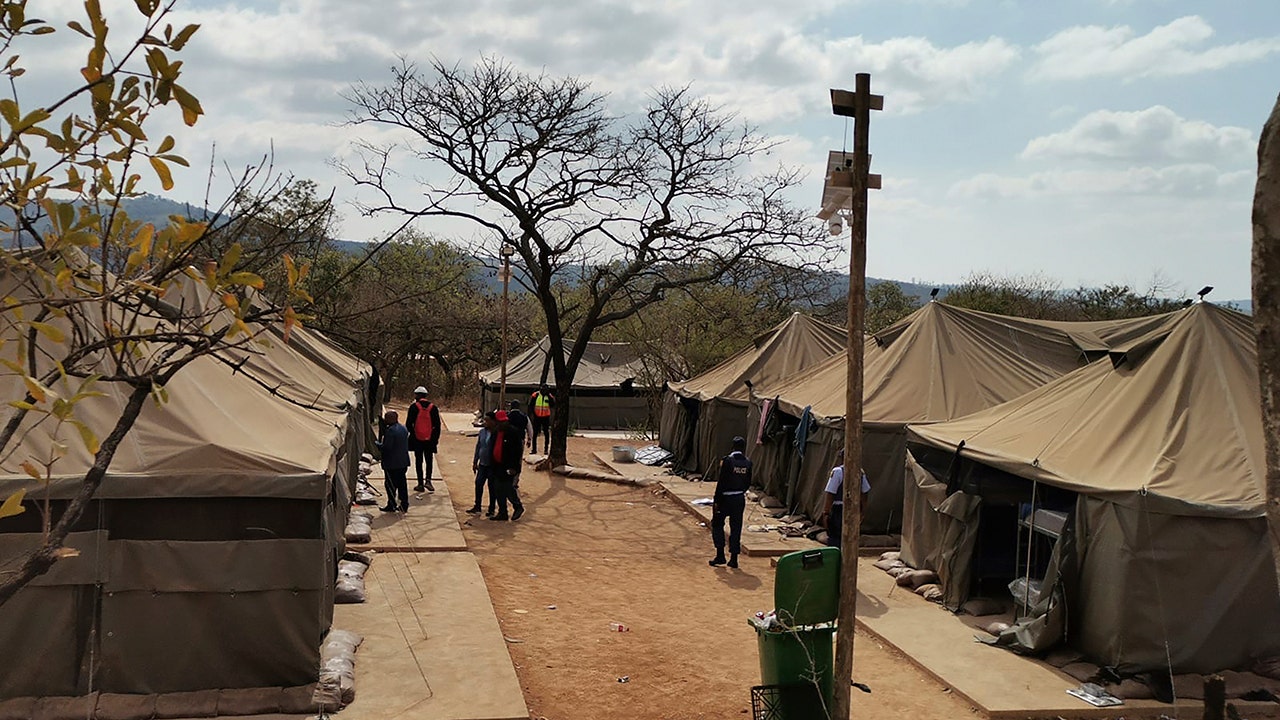Lifestyle
Looking to vacation on the California coast? Marin County just made it harder
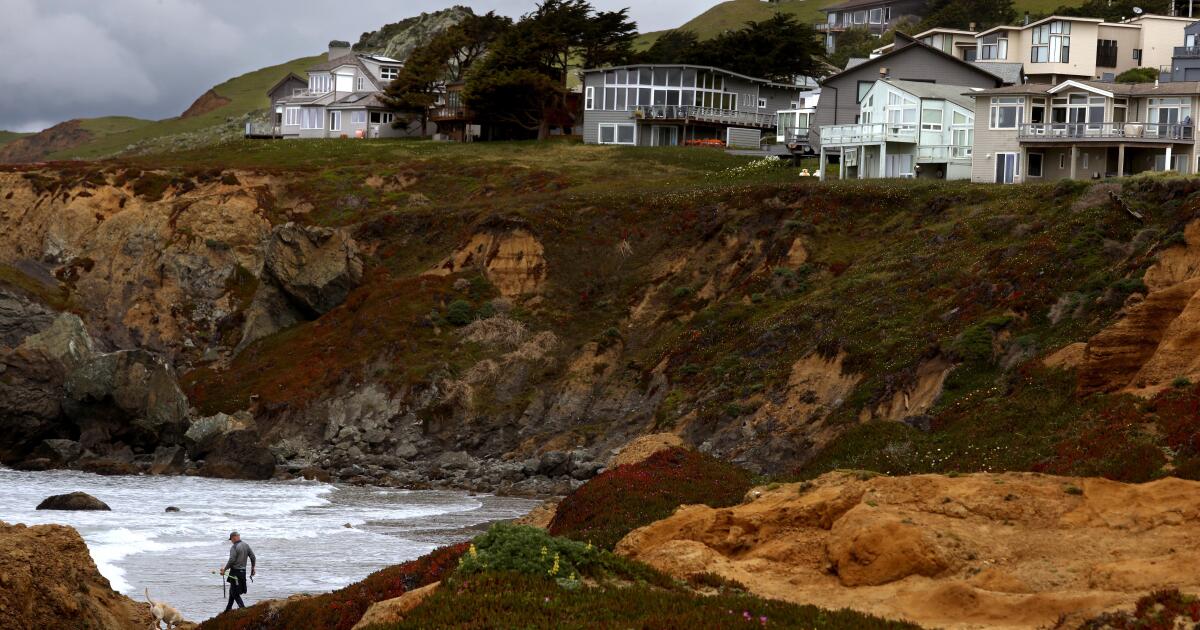
A stay in Brian Maggi’s house, per the Airbnb listing, is what coastal California dreams are made of.
“Bathed in natural sunlight,” it reads, you can “enjoy unobstructed panoramic views of the ocean and Point Reyes.” You can bring your dog. Walk to the sand. Savor “the perfect getaway” in the 1928 “BoHo surf shack.”
The little house in Dillon Beach, a remote town in western Marin County, is a second home for Maggi, a software designer who lives full time in Livermore, a hundred miles southeast.
He and his wife stay here a few weekends a month: Enough time to befriend neighbors and know the gossip, like who put in a new hot tub and who moved here to please a girlfriend despite hating the foggy weather.
“We’re not full-time residents,” Maggi said, “but we’re not absentee owners.”
“We’re really fortunate, and I get it,” Brian Maggi says of owning a second home in Dillon Beach. But he says cracking down on short-term rentals hasn’t made houses more affordable.
When Maggi is not using the house, he rents it on Airbnb for about $300 a night.
That’s a pretty common practice in Dillon Beach where, according to county estimates, a whopping 84% of the town’s 408 housing units are second homes and 31% are used as licensed short-term rentals.
Are those vacation rentals ruining California’s rugged little beach towns? Or are they opening up the coast to people who can’t afford to live there? Depends who you ask.
In Marin County, on the northern end of the San Francisco Bay, short-term rentals have become a lightning rod amid an affordable housing shortage in one of the most expensive — and beautiful — places in California.
This month, the Marin County Board of Supervisors approved a hard cap on the number of short-term rentals it will allow in unincorporated places, including the bucolic towns hugging iconic Highway 1 and the Point Reyes National Seashore.
The ordinance imposes a cap of 1,281 short-term rentals for unincorporated Marin County, where there were 923 licensed as of January.
The county has placed specific limits for 18 coastal communities, most of which will be allowed no more than the existing number of short-term rentals — while some will have to reduce their numbers. The exception is Dillon Beach, a historic vacation town where the short-term rental market will be allowed to significantly grow.

Dillon Beach homeowner Paul Martinez walks home after surfing. “Rent it responsibly,” Martinez says about owners renting out their houses when they are not in town.

Mounted surfboards add to the charm of this colorful home in Dillon Beach.
In Point Reyes Station, population 383, there are 32 short-term rentals, according to the county. Under the new rules, 26 will be allowed. In Stinson Beach, the cap will allow the amount of rentals that currently exist: 192.
In Dillon Beach, vacation rentals will be allowed to grow 63%, from 125 to 204. The town has no school and the only businesses are a resort and its general store, which supervisors noted make for a different kind of community than many of the other towns dotting the Marin coastline.
County officials said they expect the number of existing short-term rentals to shrink through attrition. Current license holders will have to reapply and adhere to stricter regulations, which can include expensive septic upgrades. The new rules allow just one short-term rental property per operator, and licenses will not transfer to new owners if a property sells.
Debate over the issue has raised questions not just about limited housing in Marin, but also about whether Airbnbs have become a critical means of providing public beach access — a right enshrined in the California Coastal Act — in seaside towns with few hotel rooms.
“Please do not codify this anti-visitor, exclusionary behavior. Do not turn a region dense in coastal public recreational lands into an exclusionary playground that only the elite can access,” Inverness resident Rachel Dinno Taylor, founder of the West Marin Access Coalition, a citizens group that fought the measure, said in a speech last month before the California Coastal Commission.
The Coastal Commission regulates development in the Coastal Zone — which is generally the first 1,000 yards from the shoreline but extends a few miles inland in some areas — and increasingly is weighing in on local efforts to limit short-term rentals.

If it weren’t for vacationers — who fill the village with laughter and kids and wagons and dogs — Dillon Beach would be dead most days, residents say.
Since 1992, the Coastal Commission has considered at least 47 short-term rental ordinances. It has approved all but four, including Marin County’s new ordinance.
“Vacation rentals can provide important public access to the coast, especially where hotels are scarce. But without thoughtful guidelines, they can also have unintended impacts on local housing availability,” Kate Huckelbridge, executive director of the Coastal Commission, said in a statement to The Times. “We think Marin County achieved the right balance for their unique and world-famous coastline.”
The West Marin Access Coalition, many of whose members rent out their homes and so have a financial stake in the debate, argued the county did not have enough data to prove short-term rentals directly affect housing availability. Many residents rely upon income generated by their rentals to afford staying in their homes, Sean Callagy, a member of the coalition, said in an email.
The county’s new policy, he wrote, will “create hardships for low- and middle-income residents, worsen housing insecurity and deny visitors access to the coast.”
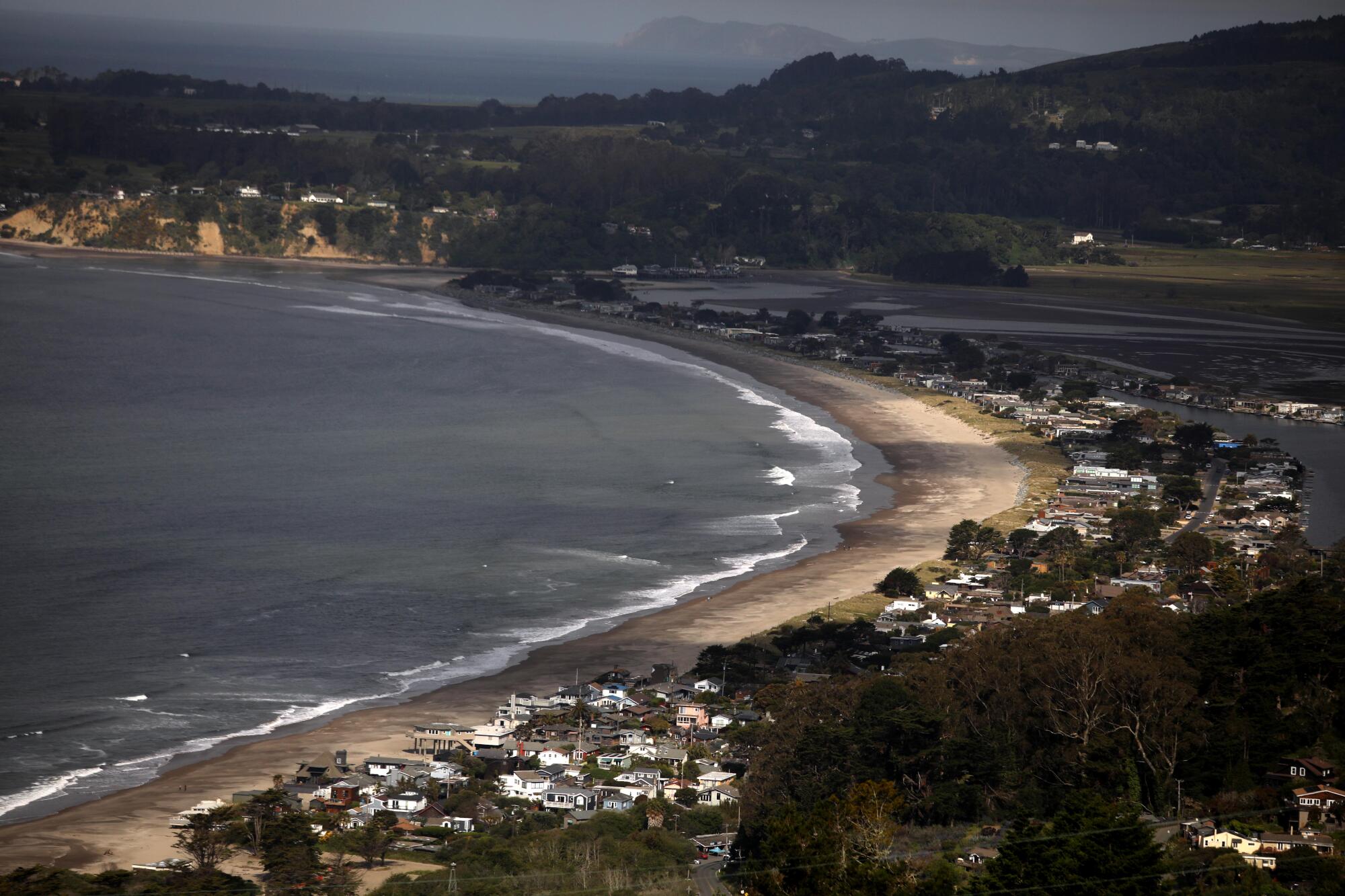
An aerial view of Stinson Beach in Marin County.
For years, high-demand destinations across California — including Los Angeles city and county, Palm Springs, Malibu, Ojai and San Francisco — have tried to rein in rental platforms such as Airbnb and Vrbo, citing the need to prevent housing from being converted into de facto hotel rooms .
In Marin County, the explosive growth in short-term rentals has been particularly divisive in smaller towns. There, the number of full-time residents is dwindling while millionaires’ second — and third — homes, many of which are used as seasonal rentals, sit empty much of the year.
That’s a cruel paradox when there are not enough affordable homes for people who work in those communities, proponents of the cap say.
In unincorporated Marin County, the median sales price of a single-family home rose 98% from 2013 to 2021, to $1.91 million, according to a countywide housing plan adopted last year.
“Housing affordability and housing supply were really the driving factor in why we’re addressing short-term rentals right now,” said Sarah Jones, director of the Marin County Community Development Agency. “There’s not housing being built. And the housing that’s available, people are just seeing that it’s more profitable and easier to use it as a short-term rental than to rent it out long term.”
Although Marin County has much open space, it has little room to expand housing. Roughly 85% of its land, including the Point Reyes National Seashore and the Golden Gate National Recreation Area, is public space or agricultural land protected from development.
Marin County Supervisor Dennis Rodoni, who represents the scenic West Marin towns where vacation rentals are most heavily concentrated, said they have transformed “tiny communities where even losing a few homes is a big deal.”
“Our volunteer fire departments are losing volunteers,” he said. “Our schoolteachers, we’re having a hard time locating them in the community; they have to commute long distances.”

Visitors stroll through downtown Stinson Beach along Highway 1 in West Marin County.
The elementary school in Stinson Beach, he noted, is “having a hard time keeping its doors open” because so few children now live there. The town’s population, according to census data, plunged 38% from 2016 to 2022, to 371. In 2022, there were no children younger than 15.
According to county estimates, 27% of housing units in Stinson Beach are used as short-term rentals — many of which are in the gated neighborhood of Seadrift, a flood-prone sand spit.
The town has “become like Martha’s Vineyard on the West Coast,” said August Temer, co-owner of Breakers Cafe on Highway 1 in Stinson Beach. “It’s not people’s primary residence.”
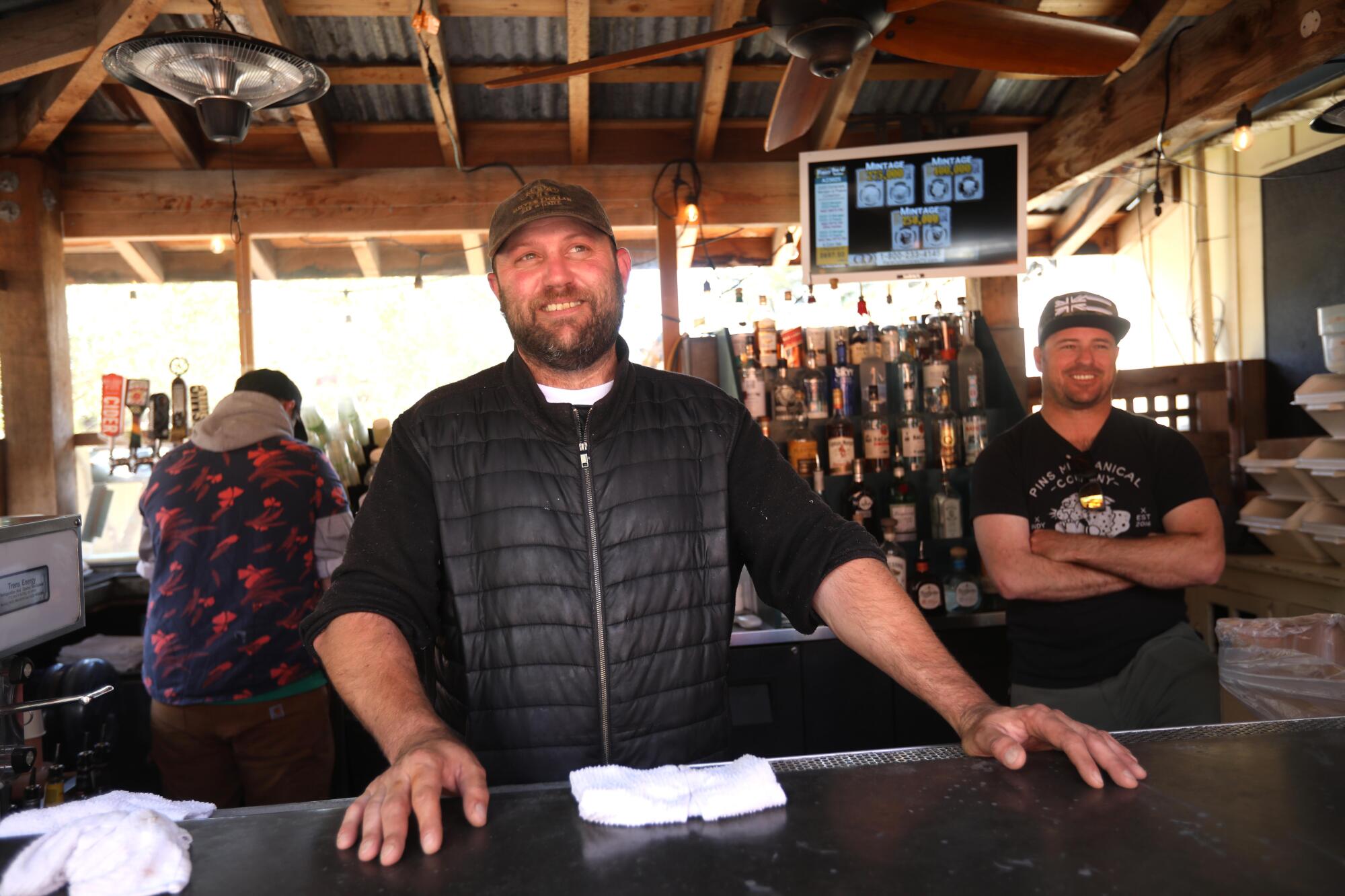
August Temer, center, co-owner of Breakers Cafe in Stinson Beach, says as a business owner he likes Airbnbs and the tourists they bring. But it’s sad, he says, that his employees can’t afford to live in town.
Standing behind the outdoor bar on a windy afternoon last month, Temer, a 45-year-old who grew up in Stinson Beach, said that as a business owner he likes Airbnbs and the money-spending tourists they bring in. But it’s sad, he said, that none of his employees can afford to live in town and must commute — which makes it difficult to keep workers.
Mac Bonn, the general manager, said he drives 45 minutes “over the hill,” traversing a winding mountain road, to his home in Fairfax.
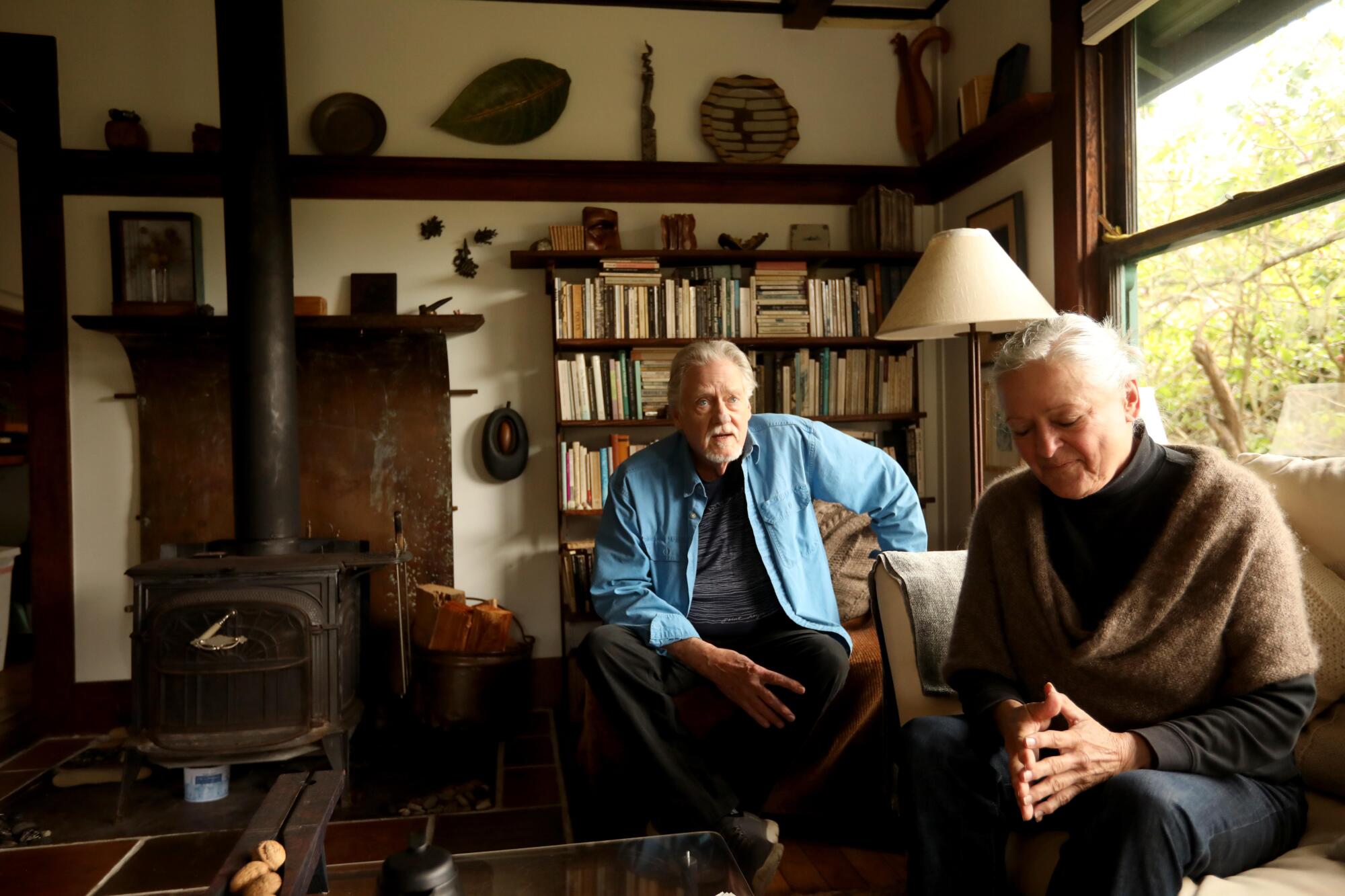
“We used to know this as very much a vibrant neighborhood,” says Bruce Bowser, seated with his wife, Marlie de Swart. “A lot if it’s thinned out. A lot of people are older and have passed or moved on.”
In nearby Bolinas, artist Marlie de Swart and husband Bruce Bowser welcomed the new rules, telling the Coastal Commission in a letter that their town “is being changed from a characteristic village to a vacation rental suburb.”
The county ordinance limits the number of short-term rentals in Bolinas to 54. There are now 63.
The septuagenarian couple bought their century-old house with picture windows and redwood ceilings in downtown Bolinas in 1992 for about $230,000. They were stunned when a nearby house recently sold for nearly $3 million after its owner died.
Bolinas is so famously opposed to outsiders that, for years, a vigilante band called the Bolinas Border Patrol cut down road signs on Highway 1 that pointed the way into town.
Alas, Google Maps directed tourists to Bolinas. And the Airbnbs kept them there.
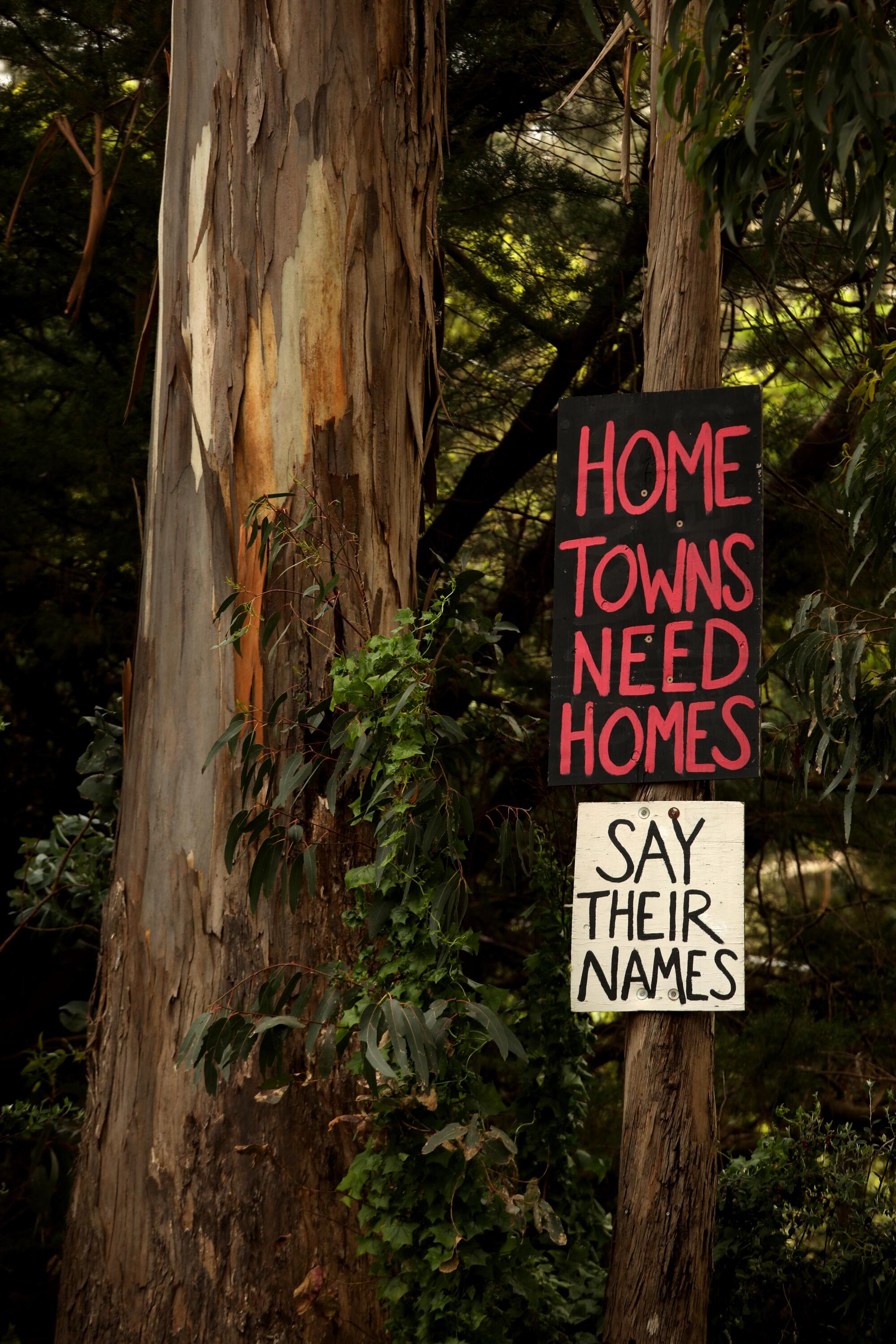
Bolinas residents say neighbors have been replaced by short-term guests and empty second homes, making the town feel more like a vacation rental suburb than a cozy hometown.
(Genaro Molina / Los Angeles Times)
During the summers, De Swart said, the town is overrun by visitors whose cars idle on narrow streets for more than an hour as they wait to park. Neighbors have been replaced by short-term guests and empty second homes.
“We used to know this as very much a vibrant neighborhood,” Bowser said. “A lot if it’s thinned out. A lot of people are older and have passed or moved on. We used to look out on this valley, and there were a lot of lights at night. Now, it’s mostly dark.”
Sitting on the couple’s living room table was a copy of the Point Reyes Light newspaper. On Page 11 was a classified ad that read: “In Search of Affordable Home,” placed by their friend, Tess Elliott, the newspaper’s publisher.
“We are the publishers of the Point Reyes Light and the assistant fire chief at the Inverness Fire Department,” the ad reads. “Please help us become permanent residents and continue to contribute to the place we love.”
Elliott, 44, said she and her husband have been running such ads for years. The mother of two young children, Elliott and her family live in an Inverness house that has been “rented to us at well below market rate” for the last decade by “a generous family.”
“It’s very fragile,” she said of life as a renter in Inverness, a town of 1,500 on the Tomales Bay with 93 registered short-term rentals. “People with kids, like us, can only take that so long. You want some stability. You want to invest in a property.”
Lately, she said, “we aren’t feeling very hopeful.”
Frank Leahy, a software engineer, bought his house a mile northwest of the newspaper office in 2020 and got a short-term rental license just before the county, in 2022, enacted a two-year moratorium on new operating licenses.
Leahy and his wife live full time in Inverness. But they travel a few weeks a year and list their house, with a bocce court out front, on Airbnb for $300 to $500 a night. Leahy said the county clamped down too broadly on short-term rental owners, conflating those who rent their homes full time and others who, like him, only rent a few weeks a year.
“I can name people who live up and down the street. If those were just rentals? It would be kind of weird,” he said. “I don’t have a problem with people wanting to rent out their home for a short amount of time.”
Leahy said short-term rentals are being scapegoated for the housing shortage in a place where it is prohibitively difficult to build.
About four years before they bought their home, he and his wife purchased an empty hillside lot nearby, planning to build a house. It took years to get all of the permits and to have the required bird, bat, geological and traffic surveys done. During that time, the cost to build rose by several hundred thousand dollars, he said. They gave up and sold the land.
On a chilly Wednesday morning last month, Dillon Beach was virtually silent — save for the plop-plop of sandals worn by a lone wetsuit-clad surfer walking home, and the tinkling of raindrops on Maggi’s windows.
With its gloomy weather, bad cell service and lack of jobs, Dillon Beach, on the south end of Bodega Bay, isn’t for everyone, Maggi said.
“A lot of the bugs in this place are its feature,” said Maggi, 54. “There’s no town. There’s no main drag. … This place has always been made of vacation homes. It’s not conducive to full-time living. It’s really far from everything.”
If it weren’t for vacationers — who fill the village with laughter and kids and wagons and dogs — the place would be dead most days, he said.
Maggi and his wife bought the house in 2020, when they and their adult children were going stir-crazy amid the pandemic. It was a financial stretch, but renting it out has helped. A gregarious Illinois native, Maggi joked that he had become a “California cliche” — a middle-aged guy with a beach house, a cool van, a border collie mix and a surfboard, even though he can’t surf well.
“We’re really fortunate, and I get it,” he said. But he finds it “kind of shameless” for the county to use the affordable housing crisis to justify cracking down on short-term rentals. The two-year ban on new licenses, he said, did not suddenly make houses cheap.
“You had this moratorium!” he said with a laugh. “How’s your affordable housing going?”

Lifestyle
'Wait Wait' for July 27, 2024: With Not My Job guest Kathleen Hanna

Kathleen Hanna of The Julie Ruin performs onstage at the 2016 Panorama NYC Festival – Day 2 at Randall’s Island on July 23, 2016 in New York City. (Photo by Nicholas Hunt/Getty Images)
Nicholas Hunt/Getty Images/Getty Images North America
hide caption
toggle caption
Nicholas Hunt/Getty Images/Getty Images North America
This week’s show was recorded in Chicago with host Peter Sagal, judge and scorekeeper Bill Kurtis, Not My Job guest Kathleen Hanna and panelists Meredith Scardino, Peter Grosz, and Mo Rocca Click the audio link above to hear the whole show.
Who’s Bill This Time
Momala Takes Over; Assigned Seats Are Back; And The Heat Is On
The Olympic Torch Reporch
Our Summer Olympics Preview
Bluff The Listener
Our panelists tell three stories about someone committing an office faux pas, only one of which is true.
Not My Job: We quiz Bikini Kill’s Kathleen Hanna on Hanna-Barbera
Punk icon Kathleen Hanna plays our game called, “Kathleen Hanna Meet Hannah-Barbera.” Three questions about the animation studio.
Panel Questions
Hide Your Receipts; VR Meets ER; Avocado Apologies
Limericks
Bill Kurtis reads three news-related limericks: Situation Room Cocktails; Burrito Bird; Hopped Up Sharks
Lightning Fill In The Blank
All the news we couldn’t fit anywhere else
Predictions
Our panelists predict what will be the big story out of the Paris Olympic Games
Lifestyle
L.A. Affairs: At 77, I had a crush on my best friend’s widower. Did he feel the same way?
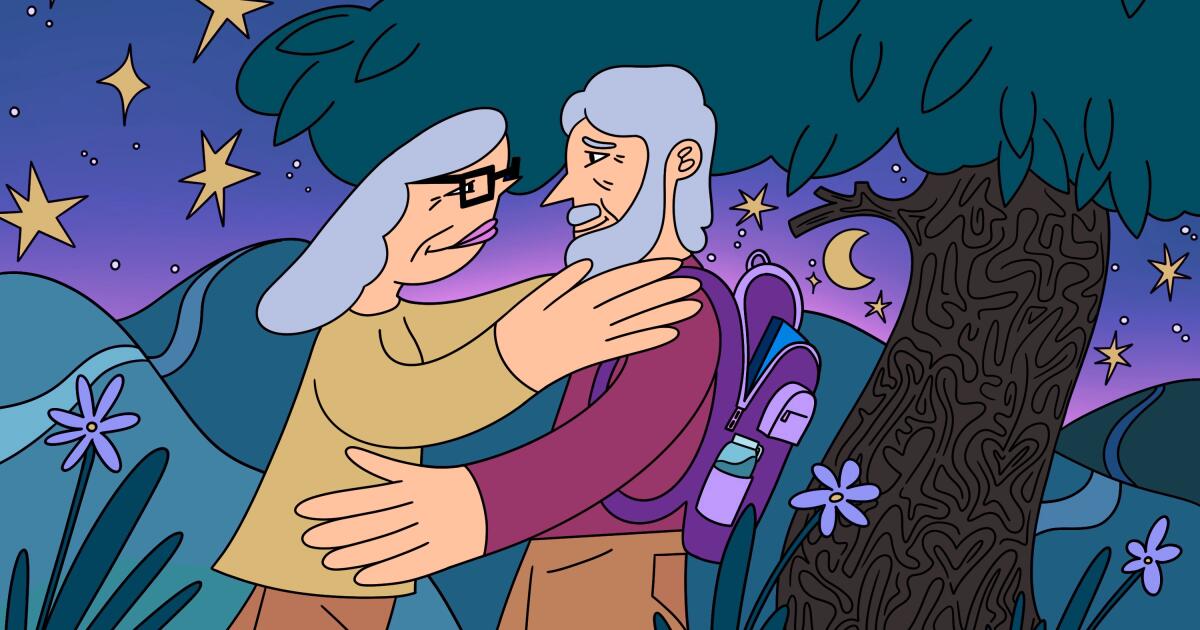
At 77, I had given up. After two failed marriages and years of unsuccessful dating, I accepted what seemed to be my fate: single for almost 40 years and single for however many remained. You don’t get it all, I told myself. I was grateful for family, friends and work. Life settled into what felt like order.
Until Ty.
As the husband of my best friend, he was no stranger, but he was usually peripheral. Then 10 years ago, my friend got lung cancer. I watched during visits, stunned at how nurturing Ty could be, taking care of her even though they had separated years before at her request.
After she died, Ty and I stayed in touch sporadically: a surprise sharing of his second granddaughter a year after we scattered my friend’s ashes, an invitation to the launch of my book a year later. Ty attended, hovering in the back, emerging after everyone left to attentively help load my car.
Two more years passed. During quiet moments, I remembered his sweetness. I also remembered his handsome face and long, tall body. Confused about what I wanted, I texted Ty, who’s an architect, under the guise of purchasing a tree for my backyard.
We spent an afternoon at the nursery, laughing, comparing options and agreeing on a final selection. When the tree arrived, I emailed a photo. He emailed a thank you.
Another three years passed, broken only by news of his third granddaughter and my memories of how good it felt to be with him. Alert to his attentiveness, but unsettled by both his remove and my growing interest, I risked reaching out again, this time about remodeling my garage.
Ty spent several hours at my house making measurements, checking the foundation and sharing pictures of his home in Topanga. His sketches for the garage arrived two weeks later via email.
I was grateful for his help but unsure over what sort of friendship we were developing, at least from his point of view. I, however, was clear. I wanted him to wrap his long arms around me, tell me sweet things and make me his.
Instead, I sent a gift card to a Topanga restaurant to thank him for his drawings.
“Maybe we should spend it together,” he texted.
We dined in the dusk of late summer. Our talk was easy. Discomfort lay in the unspoken. Anxious for clarity, I repeatedly let my hand linger near the candle flickering in the middle of our table. It remained untouched.
And that was as far as I was willing to go. I refused to be any more forward, having already compromised myself beyond my comfort level with what seemed, at least to me, embarrassingly transparent efforts to indicate my interest. Not making the first move was very important. If a man could not reach out, if he didn’t have the self-confidence to take the first step, he would not, I adamantly felt, be a good partner for me.
Two weeks later, Ty did email, suggesting an early evening hike in Tuna Canyon in Malibu. The setting was perfect. Sun sparkled off the ocean. A gentle breeze blew. We climbed uphill for sweeping coastal vistas and circled down to the shade of live oaks, touching only when he took my hand to steady me where the path was slippery. At the end of the trail, overlooking the juncture between the mountains and the sea, we stood opposite each other and talked animatedly for almost an hour, both of us reluctant to part.
Our conversation was engaging, but my inner dialogue was louder. When, I kept thinking, is this man going to suggest we continue the evening over dinner? We didn’t have to go out. We could eat at his house. It was 7 p.m., for God’s sake. Passing hikers even stopped to remark on our matching white hair and how well they thought we looked together. It was like a movie scene where the audience is yelling, “Kiss her, kiss her,” rooting for what they know is going to happen while the tension becomes almost unbearable. But bear it I did.
Each of us ate alone.
A few weeks later, at his suggestion, we were back at Tuna Canyon. This time Ty did invite me to end the evening at his house. Sitting close on his couch, but not too close, we drifted toward each other in the darkening room. His shoulder brushed mine reaching for his cup of coffee. My hip pressed his as I leaned in for my tea. Slowly, sharing wishes and hopes for our remaining years, we became shadows in the light of the moon. And in that darkness, in that illuminated space, he reached out.
This reticent man, this man who was so slow to move toward me, this sensitive man who hid himself behind layers so opaque I was unsure of his interest, released all that he had inside him.
“I wanted you,” Ty repeated again and again. “I was afraid of ruining things. You were her best friend. I didn’t want to lose your friendship.”
Our pent-up tension exploded.
Stunned and thrilled, I leaned into the space he opened.
Three years later, it is a space we continue to share: a place where neither of us has given up, a place where he wraps me in his long arms, a place we hold carefully against our diminishing days.
The author is the owner of a preschool in Venice as well as a psychotherapist, photographer and writer. Her first book, “Naked in the Woods: My Unexpected Years in a Hippie Commune,” was published in 2015. Her newest manuscript, “Bargains: A Coming of Aging Memoir Told in Tales,” is seeking a publisher. She lives in Mar Vista and can be found at margaretgrundstein.com, Instagram @margwla, Medium @margaretgrundstein and Substack @mgrundstein.
L.A. Affairs chronicles the search for romantic love in all its glorious expressions in the L.A. area, and we want to hear your true story. We pay $400 for a published essay. Email LAAffairs@latimes.com. You can find submission guidelines here. You can find past columns here.
Lifestyle
'Deadpool & Wolverine' is a self-cannibalizing slog

Ryan Reynolds stars as Deadpool and Hugh Jackman as Wolverine in an odd-couple action hero pairing.
Jay Maidment/20th Century Studios
hide caption
toggle caption
Jay Maidment/20th Century Studios
When Fox Studios released the first Deadpool movie back in 2016, it played like an irreverently funny antidote to our collective comic-book-movie fatigue. Wade Wilson, or Deadpool, was a foul-mouthed mercenary who obliterated his enemies and the fourth wall with the same gonzo energy.
Again and again, Deadpool turned to the camera and mocked the clichés of the superhero movie with such deadpan wit, you almost forgot you were watching a superhero movie. And Ryan Reynolds, Hollywood’s snarkiest leading man, might have been engineered in a lab to play this vulgar vigilante. I liked the movie well enough, though one was plenty; by the time Deadpool 2 rolled around in 2018, all that self-aware humor had started to seem awfully self-satisfied.
Now we have a third movie, Deadpool & Wolverine, which came about through some recent movie-industry machinations. When Disney bought Fox a few years ago, Deadpool, along with other mutant characters from the X-Men series, officially joined the franchise juggernaut known as the Marvel Cinematic Universe.
That puts the new movie in an almost interesting bind. It tries to poke fun at its tortured corporate parentage; one of the first things Deadpool says is “Marvel’s so stupid.” But now the movie also has to fit into the narrative parameters of the MCU. It tries to have it both ways: brand extension disguised as a satire of brand extension.

It’s also an odd-couple comedy, pairing Deadpool with the most famous of the X-Men: Logan, or Wolverine, the mutant with the unbreakable bones and the retractable metal claws, played as ever by a bulked-up Hugh Jackman.
The combo makes sense, and not just because both characters are Canadian. In earlier movies, Deadpool often made Wolverine the off-screen butt of his jokes. Both Deadpool and Wolverine are essentially immortal, their bodies capable of self-regenerating after being wounded. Both are tormented by past failures and are trying to redeem themselves. Onscreen, the two have a good, thorny chemistry, with Jackman’s brooding silences contrasting nicely with Reynolds’ mile-a-minute delivery.
I could tell you more about the story, but only at the risk of incurring the wrath of studio publicists who have asked critics not to discuss the plot or the movie’s many, many cameos. Let’s just say that the director Shawn Levy and his army of screenwriters bring the two leads together through various rifts in the multiverse. Yes, the multiverse, that ever-elastic comic-book conceit, with numerous Deadpools and Wolverines from various alternate realities popping up along the way.

I suppose it’s safe to mention that Matthew Macfadyen, lately of Succession, plays some kind of sinister multiverse bureaucrat, while Emma Corrin, of The Crown, plays a nasty villain in exile. It’s all thin, derivative stuff, and the script’s various wink-wink nods to other shows and movies, from Back to the Future to Furiosa to The Great British Bake Off, don’t make it feel much fresher. And Levy, who previously directed Reynolds in the sci-fi comedies Free Guy and The Adam Project, doesn’t have much feel for the splattery violence that is a staple of the Deadpool movies. There’s more tedium than excitement in the characters’ bone-crunching, crotch-stabbing killing sprees, complete with corn-syrupy geysers of blood.

For all its carnage, its strenuous meta-humor and an R-rated sensibility that tests the generally PG-13 confines of the MCU, Deadpool & Wolverine does strive for sincerity at times. Some of its cameos and plot turns are clearly designed to pay tribute to Fox’s X-Men films from the early 2000s.
As a longtime X-Men fan myself, I’m not entirely immune to the charms of this approach; there’s one casting choice, in particular, that made me smile, almost in spite of myself. It’s not enough to make the movie feel like less of a self-cannibalizing slog, though I suspect that many in the audience, who live for this kind of glib fan service, won’t mind. Say what you will about Marvel — I certainly have — but it isn’t nearly as stupid as Deadpool says it is.

-

 World1 week ago
World1 week agoOne dead after car crashes into restaurant in Paris
-

 Midwest1 week ago
Midwest1 week agoMichigan rep posts video response to Stephen Colbert's joke about his RNC speech: 'Touché'
-

 News1 week ago
News1 week agoVideo: Young Republicans on Why Their Party Isn’t Reaching Gen Z (And What They Can Do About It)
-

 News1 week ago
News1 week agoIn Milwaukee, Black Voters Struggle to Find a Home With Either Party
-

 Politics1 week ago
Politics1 week agoFox News Politics: The Call is Coming from Inside the House
-

 News1 week ago
News1 week agoVideo: J.D. Vance Accepts Vice-Presidential Nomination
-

 Movie Reviews1 week ago
Movie Reviews1 week agoMovie Review: A new generation drives into the storm in rousing ‘Twisters’
-

 World1 week ago
World1 week agoTrump to take RNC stage for first speech since assassination attempt



/cdn.vox-cdn.com/uploads/chorus_asset/file/25547838/YAKZA_3840_2160_A_Elogo.jpg)
